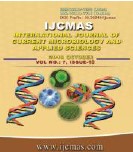


 National Academy of Agricultural Sciences (NAAS)
National Academy of Agricultural Sciences (NAAS)

|
PRINT ISSN : 2319-7692
Online ISSN : 2319-7706 Issues : 12 per year Publisher : Excellent Publishers Email : editorijcmas@gmail.com / submit@ijcmas.com Editor-in-chief: Dr.M.Prakash Index Copernicus ICV 2018: 95.39 NAAS RATING 2020: 5.38 |
Biofilms are surface associated bacterial communities surrounded by a matrix of exopolymers. Biofilms contribute to the development of persistent infections due to their refractiveness to antibiotic therapy. The purpose of this study was to evaluate three methods for detection of biofilm formation in different indwelling devices. For detection of biofilm formation, out of the 100 indwelling devices processed, 52 bacterial isolates showed growth and these were subjected for biofilm production detection by tissue culture plate (TCP) method, Tube method (TM) and Congo red agar (CRA) method. Of the 52 bacterial isolates, 42 isolates (80.7%) were found to be biofilm producers. The present study revealed that maximum number of biofilm producers, were isolated from the endotracheal tubes (E.T.T.’s) (86%). The most common organism producing biofilm from the E.T.T.’s was Klebsiella pneumoniae (36%). Biofilm producers from the intravenous catheter tips (I.V.C.) were 80%, out of which S. epidermidis (45%) was found to form highest number of biofilm producers. Klebsiella pneumoniae (25%) produced biofilm from Nasogastric tubes (N.G.T.) and 20% of Acinetobacter baumanii produced biofilms in Inter Costal Drain tubes (I.C.D.). Out of the 52 isolates subjected for biofilm Production, T.C.P. Method detected 42 (80.7%), T.M. Method detected 38 (66%), C.R.A. Method detected 8 (14%) of the biofilm Producers. Out of the 42 isolates which produced biofilms by T.C.P. method, 10 (23%) were strong, 26 (62%) were moderate & 6 (14%) were weak biofilm producers. Out of the 38 isolates which produced biofilms by T.M., 4(10.5%) were strong, 28 (66%) were moderate, 8 (19%) were weak biofilm Producers. Among the different microorganisms, the frequency of biofilm production showed by 42% of P. aeruginosa isolates, 37.5% of A. baumanii, 25% E. coli, 14% of K. pneumoniae. In our study we found that TCPM was the gold standard phenotypic method used for detection of biofilms in resource limited settings. Our study did not recommend C.R.A. method for screening of biofilms due poor sensitivity
 |
 |
 |
 |
 |